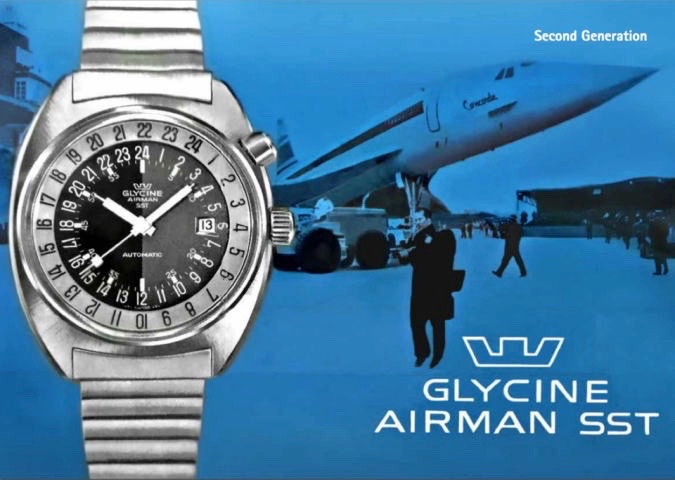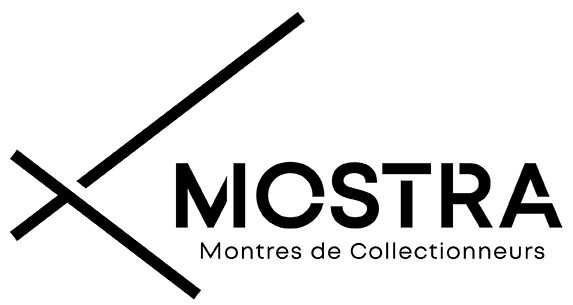
The Glycine Airman is a pilot's watch, very popular in the military air forces of the mid-twentieth century. This model, which was also adopted by a large number of civilian pilots during the 50s and 60s, was very successful due to its approval by the powerful American pilots federation AOPA. Association whose members benefited from a preferential price when purchasing this watch. Its popularity in the 1960s was at its peak and it was not uncommon to see it on the wrist of the crews of most airlines of the time.
A new edition of this watch will extend its career in the 1970s with a more “PopArt” case shape, an original version of the Airman which will be marketed on the American market at the time of the appearance in the sky European Concorde and the unfortunate Tupolev 144 of Aeroflot.
As far as airplanes are concerned, the reaction of the American aeronautical industry is not long in coming with the start of construction by Boeing of the 2707 SST project (SST = Super-Sonic Transport). This project, in the form of a supersonic long-haul aircraft, is intended for the American airline market and, from a general point of view, for the competitors of British Airways and Air France equipped with the Concorde as well as Aeroflot which, quite naturally appears on the Tupolev 144.
IMAGE
This program will focus on an aircraft capable of cruising at Mach 2.7, i.e. 0.7 M. more than British Aerospace's Concorde and carrying between 250 and 300 passengers within a range of 6750 kilometers . A tapered fuselage framed by variable-geometry wings to deploy at low speeds and retract in a delta at supersonic speeds. This long-haul project will be abandoned for reasons of profitability and environmental impacts (the frequent passage at the speed of sound in habitable areas). This research, on the other hand, will be largely recycled in the military field and lead to the F-111 and the famous F14 Tomcat (Topgun) for the wings, as well as to develop the Bombardier B1 with its engine nozzles at the rear.
The United States of America being by far the country with the most pilots, Glycine will develop specific production for the American market with models that are sometimes more economical because they are manufactured on a large scale, and generally not marketed elsewhere.
This particular production of which La Glycine Airman SST and its revisited limited version Airman Spécial are the typical example that marks this period.
One model for 2 variants,
IMAGE
Initially, Glycine will produce the Airman SST, a watch that keeps a dial in 24 hours and indications in 60 minutes, identical in all respects to the original Glycine Airman. The dial, on the other hand, is somewhat different: equipped with a disc that always lasts 24 hours but whose operation has been reviewed. This disc, in orange color, is positioned under the glass, on the periphery of the Dial. It displays the time difference on arrival, by aligning the values of two series of markers in 24 hours.
The orange disc is combined with a pusher which does not sink into the case, but which rotates like a crown, in order to match the local or starting times in the part of the black dial and their time difference provided on the disc. orange.
For the minutes, the reading is done regardless of the hour in the inner part of the black dial, in a circular arrangement under the tritium indexes which segment the hours from the minutes on a circular railroad.
In the context of civil aviation which makes airline pilots the prestigious adventurers of modern times, the appearance of shirt sleeves worn by abrasive crowns is experienced as an attack on the glamorous image that these pilots wish to embody. Glycine will therefore use a smooth GMT crown operation pusher integrated into the case in its upper right part. This will spare the uniforms of flight personnel.
IMAGE
Still in the same spirit, the sharp-edged notched rotating bezel of the previous model disappears from the case to pass under the glass, the condition of the sleeves of these elegant costumes will therefore be preserved.
The Glass, of flattened shape and of large size, covers an extremely readable dial, so as to avoid any ricochet of parasitic reflections from the sun in the cockpit, the dial practically joining the handles of the watch and the lateral ends of the case in order to take advantage of to the maximum of the dimensions of the box to improve the reading of the time.
To continue on the care taken by Glycine to the readability of this watch in a day/night atmosphere, the color of the disc, Orange Mat will prove to be particularly visible and contrasted in the tinted and subdued light which reigns in the cockpits at night.
IMAGE
Indeed, these special lamps make it possible not to penalize the visual acuity of pilots at night, to regulate the physiological mechanisms inherent in glare, and to generate visual comfort capable of reducing fatigue due to the use of conventional lamps.
The thickness of the case is for an automatic watch, extremely thin, which provides unparalleled comfort under a uniform vis-à-vis its direct competitors which are: The Rolex GMT Master, The Breitling Navitimer (of which you can consult the story by following this link) or the Omega Flight Master, all three much thicker.
This low thickness is also due to the choice not to use a stopwatch, given the evolution of air traffic control procedures.
Indeed, the continuous exchange of information maintained by crews and air traffic controllers during navigation phases since the end of the 1960s, and the exact monitoring of the weather, being assisted by contact with the air traffic controllers during the guidance of departure or approach phases, the carrying of an additional timing device by the pilots to ensure flight safety is no longer as essential.
IMAGE
The automatic movement that Glycine will choose for the Airman “Supersonic” model will also be an opportunity to reduce the size of the case: it is the A.Shield AS1903 movement designed to operate on the hour scale in 24 hours with date, it will be used from 1967 to 1971, followed by the caliber AS2063 from 1971 to 1974, a most efficient and reliable movement which will reinforce its popularity and finally to finish, between 1974 and 1978, Glycine will opt for the evolved version of the latter with the use of the AS2163 caliber. The following Airman models will be powered by quartz movements and will give Breitling the opportunity to regain first place in the preferences of members of the pilot community with the takeover of the firm by Ernest Schneider in the 1980s.
The second model of the Airman Special Supersonic glycine (without the SST logo on the dial but engraved on the back of the case) is an extremely rare watch and practically impossible to find in Europe because it has never been marketed outside the United States except for rare Canadian exceptions.
IMAGE
It has the same characteristics as the conventional model but was designed around the AS 1701 movement in its "advanced" versions in order to meet the wide demand from the American market following its listing by AOPA instead of the Breitling Navitimer models, (watch whose history you will find by following this link)
True to its tradition, Glycine will allow members of the association of pilots and aircraft owners to acquire this model at a preferential rate.
